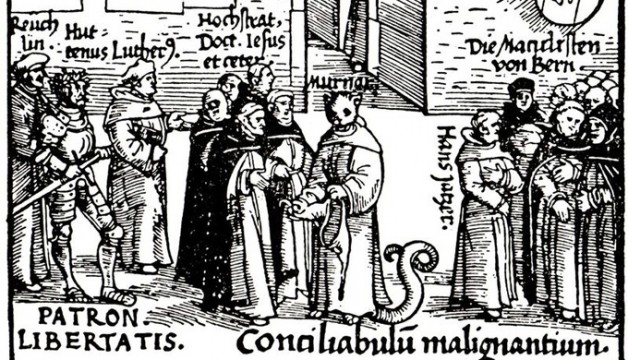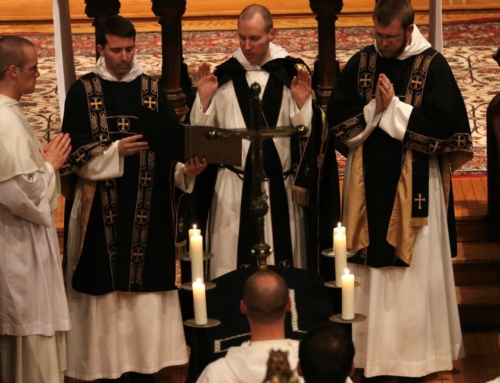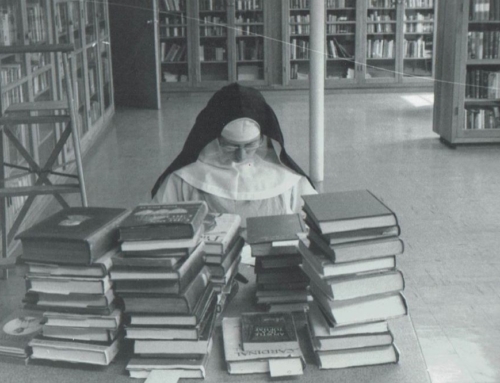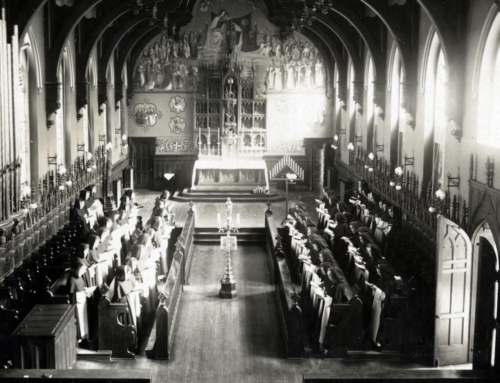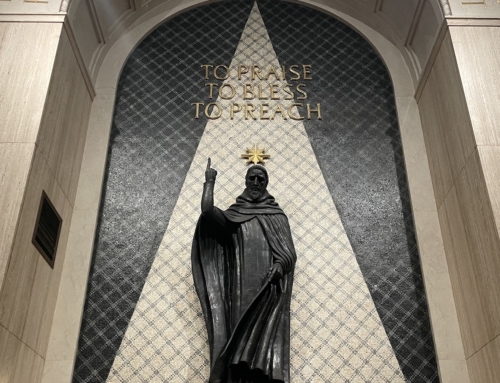We often don’t really look at something when we expect that we already know what it’s all about. Take for instance a pamphlet I came across recently: a grey little booklet titled “Saint Dominic,” with our holy father depicted in a red single-color image, and a triangle in the upper right corner labeling it as part of the “Dominican Saints of the Rosary Series.” Having read Vicaire, the five-hundred-and-thirty-five page critical life of the founder of the Dominican order, I might easily have assumed that there would be nothing of interest to me in this little pamphlet, and moved on to some more interesting item on the free-to-take table in our priory. Nevertheless, moved by some whim, I picked it up. But before I began to read the pamphlet itself–and here I must confess, I have still not read it–I happened to turn to the back cover of the pamphlet. What I found more than repaid the passing interest I bestowed on the document, for here I encountered a work of Dominican comic genius.
SAINTS OF THE ROSARY SERIES
ST. ALBERT… An outstanding scientist, he built what was probably the first greenhouse. Looked on as a magician because he could grow summer flowers in wintertime in his greenhouse.
ST. ANTONINUS… He was small, so they called him Little Antony. But his deeds were mighty.
ST. CATHERINE DE RICCI… She was allowed by God to see and enact in their order the scenes which preceded our Saviour’s Crucifixion.
ST. CATHERINE OF SIENA… She changed history when she persuaded the Pope to change his mind.
ST. DOMINIC… Received the Rosary from Our Lady and changed the prayer habits of the world. Founded the Dominican Order.
ST. LOUIS… A mighty missioner in the newly discovered Americas.
ST. JOHN MACIAS… Intimate friend of St. Martin. Still merits the name of the Soft-Hearted Saint.
ST. MARGARET OF HUNGARY… Holiness ran in her family. Her sister was also canonized.
ST. MARTIN DE PORRES… Everybody’s friend and helper. Animals of all shapes and sizes flocked around him.
ST. THOMAS AQUINAS… One of the greatest thinkers of all time, was also far, far too fat.
ST. RAYMOND OF PENNAFORT… Once sailed 180 miles in six hours… on his cloak.
ST. ROSE OF LIMA… Led a life of extreme penance. So beautiful, she stopped the traffic.
ST. VINCENT FERRER… Met a woman who was very plain and wanted to be beautiful. He said a prayer and she had her wish. He was also called Wonderworker.
ST. HYACINTH… Saved the Blessed Sacrament from sacrilege by sailing across the sea… on his cloak!
ST. AGNES OF MONTEPULCIANO… Dominican Contemplative Nun.
ST. PETER MARTYR… who wrote the Creed in his blood.
SAINT PIUS V… Pope of the Rosary.
How can one describe a saint in just a sentence? How can one capture the distinct graces that God has given to the individuals who are the pride of the Order? As I read and reread the descriptions, my admiration continued to grow. The author of this list, presumably one of the Irish Dominicans who administer the St. Martin de Porres Apostolate in Parnell Square, has, in my opinion, managed to capture the spirit of the Order. He did this principally by the great variation in tone that he employs throughout the document. Some saints, like St. Albert, are given delightful but inconsequential anecdotes; others, like Thomas Aquinas, are given both accolades and mocking rebukes; others are given staid descriptions which in the context take on a humor all their own.
“In many and various ways God spoke of old to our fathers by the prophets; but in these last days he has spoken to us by a Son” (Heb 1:1). In that Son, God continues to speak in many and various ways, particularly through the variety of the Church’s saints filled with the Holy Spirit, as St. Paul says: “Now there are varieties of gifts, but the same Spirit; and there are varieties of service, but the same Lord; and there are varieties of working, but it is the same God who inspires them all in every one” (1 Cor 12:4-6). The Dominican Order has been particularly blessed with saints who have been both many and various–various in their character, in their eccentricities, in their apostolates–but in their different ways they all speak to us about the Son.
Image: 1521 Pamphlet, Reuchlin and Luther Against the Dominicans

